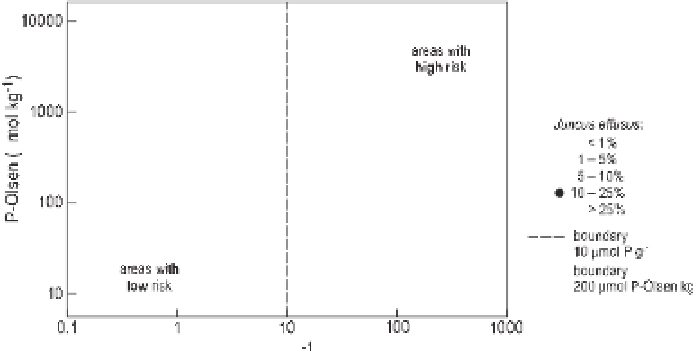Environmental Engineering Reference
In-Depth Information
Figure 14.6
Areas of high and low risk for future dominance of
Juncus effusus
based on its current cover abundance and the
current level of available and total P in the soil. (Modifi ed from Bekker 2009 .)
Box 14.2 Effects of topsoil removal - case studies in the Netherlands
After 20 years of practice, Bekker (2009) evaluated
over 300 sites where topsoil removal had taken place
in the Netherlands, by reading through plans, data-
bases and status reports of authorities in charge of
nature conservation. A subset of 42 sites was selected
to be included into a fi eld survey during 2006 and
2007. These sites were monitored for the actual veg-
etation and soil samples were taken. Thus the relation-
ship between plant cover, species composition and
soil nutrient parameters nitrogen and phosphorus
could be established.
The abundance of plant species characteristic of
nutrient-poor soil conditions was negatively related to
the cover of the newly established vegetation. It
appears that the longer bare soil is available in the
vegetation after topsoil removal, the more chance the
target species of dry grasslands and heathlands have
to establish. Sites with
<
200
μ
mol P-Olsen kg
−
1
and
<
10
μ
mol P kg
−
1
were identifi ed as being at relatively
low risk for the spreading of
Juncus effusus
(Figure
14.6). The amount of topsoil removed also plays a role.
The less nutrients (organic matter) were left after
toposil removal, the more successful the vegetation
developed. Yet, these sites need a vaste amount of
follow-up management to prevent tree species and
common rush (
Juncus effusus)
from dominating the
vegetation within a few years.
Topsoil removal is not only important for plant
species. Fifteen out of 16 butterfl y species character-
istic of plant communities on nutrient-poor soils
managed to colonize sites after topsoil removal. Some,
mostly Red List species, populated the stripped sites
at much lower abundancies than the surrounding
nature reserves. However, over 75% of the species
pool of butterfl ies in the neighbourhood was found in
each of the sites after topsoil removal. The expansion
of butterfl y species characteristic of oligotrophic habi-
tats was positively related to the size of the site, time
after removal and the successful establishment of
plant communities characteristic of nutrient-poor soil
conditions. For rare species, the distance to source
populations poses an additional constraint.
It can be concluded that successful restoration of
communities of nutrient-poor soil conditions is only
possible when phosphate levels after removal are low.
Characteristic butterfl y species can only establish
when the target plant community has established.


































